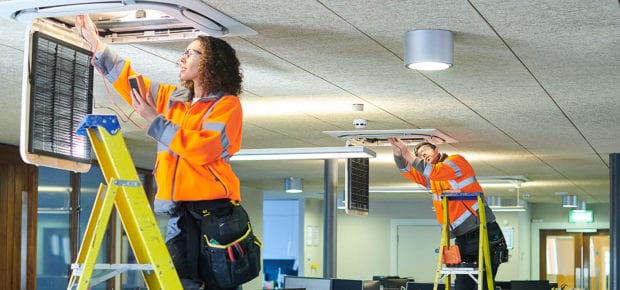May 19, 2020
As employers around the world begin to explore how to safely return employees to workplace environments, air ventilation systems and their potential role in airborne virus spread are starting to come into question. We wondered if air sensor technology might have the ability to help with virus detection?
Air sensors in ventilation systems currently cannot detect COVID-19. But it is possible that one day this technology may be augmented to help us understand and monitor diseases and illnesses.
We asked half a dozen IEEE Impact Creators for their expert perspectives on the possibility of such technology assisting in the fight against this virus, and how our workplaces may be affected by COVID-19.
 1. New Buildings and Renovations Will Be Affected
1. New Buildings and Renovations Will Be Affected
“It is likely that sensors for the specific purpose of evaluating ventilation conditions of an environment should be developed. Nevertheless, this should also impact the architecture of new buildings or the renovation of old buildings, in particular, if new regulations start appearing to ensure a certain level of ventilation at different places.” — Artur Ziviani, IEEE Senior Member
 2. Bioaerosols are Complex
2. Bioaerosols are Complex
“Although experts don’t seem to agree on whether COVID-19 is airborne or not (except for very specific circumstances, such as when intubating an infected patient), the issue is still relevant, not only for this one, but also for inevitable future epidemics. It would fall into the more general question of detecting ‘bioaerosols’. There are devices capable of capturing the particles of mucus or saliva coming out of someone’s mouth. However, the question of establishing in real-time whether they contain viruses, let alone detecting the presence of a specific virus, is much more complex. In addition, there are other unknowns: for example, what is the minimum dose of infection (the amount of particles that would be necessary to breathe and, consequently, the exposure time so that there is a significant probability of infection), and how far can droplets travel? Such parameters may vary widely for different viruses, probably making it difficult to precisely characterize what ‘good ventilation’ would mean in general.” — Raul Colcher, IEEE Life Senior Member
 3. It’s Going to Take More Technology Than Air Sensors
3. It’s Going to Take More Technology Than Air Sensors
“Sensors can pick up different signals. In addition to temperature, pressure and humidity, they can also obtain concentrations of gases and particulate materials, among others. The software, which controls the sensors that capture these signals, can assess conditions to interfere with the environment the sensors are in. In this way, the sensors can provide information to software that controls other devices to redirect air flows and thus decrease the concentration of gases or particulate matter. The analysis of this data obtained in real-time by the sensors and the almost immediate action of the actuators – software-controlled – requires reasonable processing power. Not only to process data quickly, but also to evaluate the results of decision making.” — André Leon Gradvohl, IEEE Senior Member
 4. Filters Might Help
4. Filters Might Help
“The best action in this domain seems to be the use of filters. Several ultraviolet light or ozone-based filters that kill viruses and bacteria have existed for years. The technology to detect viruses in the air, as far as I know, does not exist. It also seems that there is no consensus on how long a virus can remain active and infectious in the air.” — Anderson Maciel, IEEE Member
 5. Sensors Help Detect Air Pollution
5. Sensors Help Detect Air Pollution
“Sensors can help us identify air pollution, which is very difficult for the human senses to detect. There are numerous sensors for measuring air quality, and identifying the contaminants is the next step. Sensors in a room can record the quality of the air as well as the quantity of movement of air to detect whether proper ventilation is available. It is also possible to detect room temperature, humidity and other parameters, which can help in identifying the personal comfort of the people in the room.” —Ramalatha Marimuthu, IEEE Senior Member
 6. Detection Will Be Needed for Recycled Air
6. Detection Will Be Needed for Recycled Air
“Expect to see sensors installed by air vents in buildings to measure air flow and provide feedback on the need to increase or decrease flow. Closed loop systems that recycle air will also need sensors to monitor the air quality and ensure pollutants or airborne viruses are not spreading.” — Paul Kostek, IEEE Senior Member
7 . Sensors Keep Us on Top of Air Maintenance
. Sensors Keep Us on Top of Air Maintenance
“Air flow sensors can help. Also sensors that can detect air quality in the ventilation system can help. Sensors may also be used to determine that dangerous conditions exist, or that may encourage fungal or bacterial growth. Sensors can also determine the effectiveness of air filters and alert maintenance folks when these need changing.” —Tom Coughlin, IEEE Fellow





 Quantum and AI: Safeguards or Threats to Cybersecurity?
Quantum and AI: Safeguards or Threats to Cybersecurity? Why AI Can't Live Without Us
Why AI Can't Live Without Us Bits, Bytes, Buildings and Bridges: Digital-Driven Infrastructure
Bits, Bytes, Buildings and Bridges: Digital-Driven Infrastructure Impact of Technology in 2024
Impact of Technology in 2024 Emerging AI Cybersecurity Challenges and Solutions
Emerging AI Cybersecurity Challenges and Solutions The Skies are Unlimited
The Skies are Unlimited Smart Cities 2030: How Tech is Reshaping Urbanscapes
Smart Cities 2030: How Tech is Reshaping Urbanscapes Impact of Technology 2023
Impact of Technology 2023 Cybersecurity for Life-Changing Innovations
Cybersecurity for Life-Changing Innovations Smarter Wearables Healthier Life
Smarter Wearables Healthier Life Infrastructure In Motion
Infrastructure In Motion The Impact of Tech in 2022 and Beyond
The Impact of Tech in 2022 and Beyond Cybersecurity, Technology and Protecting Our World
Cybersecurity, Technology and Protecting Our World How Technology Helps us Understand Our Health and Wellness
How Technology Helps us Understand Our Health and Wellness The Resilience of Humanity
The Resilience of Humanity Harnessing and Sustaining our Natural Resources
Harnessing and Sustaining our Natural Resources Creating Healthy Spaces Through Technology
Creating Healthy Spaces Through Technology Exceptional Infrastructure Challenges, Technology and Humanity
Exceptional Infrastructure Challenges, Technology and Humanity The Global Impact of IEEE's 802 Standards
The Global Impact of IEEE's 802 Standards Scenes of our Cyber Lives: The Security Threats and Technology Solutions Protecting Us
Scenes of our Cyber Lives: The Security Threats and Technology Solutions Protecting Us How Millennial Parents are Embracing Health and Wellness Technologies for Their Generation Alpha Kids
How Millennial Parents are Embracing Health and Wellness Technologies for Their Generation Alpha Kids Space Exploration, Technology and Our Lives
Space Exploration, Technology and Our Lives Global Innovation and the Environment
Global Innovation and the Environment How Technology, Privacy and Security are Changing Each Other (And Us)
How Technology, Privacy and Security are Changing Each Other (And Us) Find us in booth 31506, LVCC South Hall 3 and experience the Technology Moon Walk
Find us in booth 31506, LVCC South Hall 3 and experience the Technology Moon Walk Virtual and Mixed Reality
Virtual and Mixed Reality How Robots are Improving our Health
How Robots are Improving our Health IEEE Experts and the Robots They are Teaching
IEEE Experts and the Robots They are Teaching See how millennial parents around the world see AI impacting the lives of their tech-infused offspring
See how millennial parents around the world see AI impacting the lives of their tech-infused offspring Take the journey from farm to table and learn how IoT will help us reach the rising demand for food production
Take the journey from farm to table and learn how IoT will help us reach the rising demand for food production Watch technical experts discuss the latest cyber threats
Watch technical experts discuss the latest cyber threats Explore how researchers, teachers, explorers, healthcare and medical professionals use immersive technologies
Explore how researchers, teachers, explorers, healthcare and medical professionals use immersive technologies Follow the timeline to see how Generation AI will be impacted by technology
Follow the timeline to see how Generation AI will be impacted by technology Learn how your IoT data can be used by experiencing a day in a connected life
Learn how your IoT data can be used by experiencing a day in a connected life Listen to technical experts discuss the biggest security threats today
Listen to technical experts discuss the biggest security threats today See how tech has influenced and evolved with the Games
See how tech has influenced and evolved with the Games Enter our virtual home to explore the IoT (Internet of Things) technologies
Enter our virtual home to explore the IoT (Internet of Things) technologies Explore an interactive map showcasing exciting innovations in robotics
Explore an interactive map showcasing exciting innovations in robotics Interactively explore A.I. in recent Hollywood movies
Interactively explore A.I. in recent Hollywood movies Get immersed in technologies that will improve patients' lives
Get immersed in technologies that will improve patients' lives